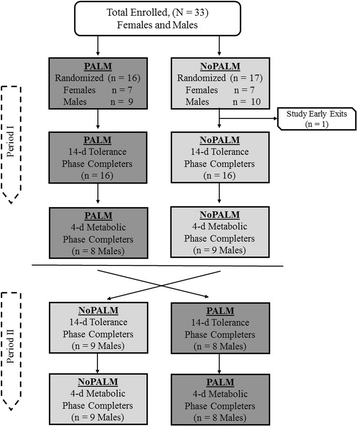Milk protein-based formulas containing different oils affect fatty acids balance in term infants: A randomized blinded crossover clinical trial
- PMID: 28410612
- PMCID: PMC5391586
- DOI: 10.1186/s12944-017-0457-y
Milk protein-based formulas containing different oils affect fatty acids balance in term infants: A randomized blinded crossover clinical trial
Abstract
Background: Palm olein is used in infant formula fat blends in order to match the fatty acid profile of human milk. While the effects on fatty acid balance have been evaluated, the use of palm olein in combination with palm kernel oil and supplementation with docosahexaenoic acid (DHA) and arachidonic acid (ARA) has not been similarly assessed in infants. This study evaluated the effects of infant formulas containing different fat compositions on the balance of fat, fatty acids, and calcium.
Methods: In this randomized, crossover, double-blinded study, 33 healthy term infants (68-159 ± 3 days of age at enrollment) were fed two formulas for 14 days in a tolerance period, followed by a 4-day metabolic balance period in 17 of the male subjects. The study compared two commercially available milk-based powdered formulas in Brazil; the PALM formula contained palm olein (44%), kernel palm oil (21.7%), and canola oil (18.5%) as the predominant fats, whereas the NoPALM formula contained other fat sources.
Results: Fat absorption (%) was greater for NoPALM versus PALM-fed infants (96.55 and 95.50%, respectively; p = 0.023). The absorption percentage of palmitic acid (C16:0) did not differ significantly between formulas (p > 0.05), but this acid was excreted at significantly higher concentrations in the PALM (29.42 mg/kg/day) than in the NoPALM (12.28 mg/kg/day) formula groups. DHA and ARA absorption percentages were also higher in NoPALM-fed infants. Calcium absorption was higher in NoPALM-fed infants (58.00%) compared to those fed PALM (40.90%), but the difference was not significant (p = 0.104) when calcium intake was used as a covariate. However, calcium retention was higher in NoPALM-fed infants compared to that in PALM-fed infants with or without calcium intake as a covariate. Adverse events did not differ between groups (p > 0.05).
Conclusions: The absorption of essential fatty acids was similar for both formulas; however, long-chain polyunsaturated fatty acids (DHA and ARA) were better absorbed from the NoPALM formula. Fat absorption and calcium retention were lower in term infants fed the PALM-based formula.
Clinical trial registration: Clinicaltrial.gov # NCT00941564 .
Keywords: Brazilian infants; Fatty acid balance; Infant formula; Kernel palm oil; Palm olein.
Figures
Similar articles
-
A Scoping Review of Clinical Studies in Infants Fed Formulas Containing Palm Oil or Palm Olein and Sn-2 Palmitate.J Nutr. 2021 Oct 1;151(10):2997-3035. doi: 10.1093/jn/nxab246. J Nutr. 2021. PMID: 34510181 Free PMC article.
-
Calcium and fat metabolic balance, and gastrointestinal tolerance in term infants fed milk-based formulas with and without palm olein and palm kernel oils: a randomized blinded crossover study.BMC Pediatr. 2013 Dec 24;13:215. doi: 10.1186/1471-2431-13-215. BMC Pediatr. 2013. PMID: 24367946 Free PMC article. Clinical Trial.
-
Palm olein in infant formula: absorption of fat and minerals by normal infants.Am J Clin Nutr. 1996 Sep;64(3):291-6. doi: 10.1093/ajcn/64.3.291. Am J Clin Nutr. 1996. PMID: 8780336 Clinical Trial.
-
Lower calcium absorption in infants fed casein hydrolysate- and soy protein-based infant formulas containing palm olein versus formulas without palm olein.J Am Coll Nutr. 2002 Dec;21(6):564-9. doi: 10.1080/07315724.2002.10719256. J Am Coll Nutr. 2002. PMID: 12480803 Clinical Trial.
-
Dietary PUFA for preterm and term infants: review of clinical studies.Crit Rev Food Sci Nutr. 2005;45(3):205-29. doi: 10.1080/10408690590956378. Crit Rev Food Sci Nutr. 2005. PMID: 16048149 Review.
Cited by
-
A Scoping Review of Clinical Studies in Infants Fed Formulas Containing Palm Oil or Palm Olein and Sn-2 Palmitate.J Nutr. 2021 Oct 1;151(10):2997-3035. doi: 10.1093/jn/nxab246. J Nutr. 2021. PMID: 34510181 Free PMC article.
-
Utilization of Agro-Industrial Residues in the Rearing and Nutritional Enrichment of Zophobas atratus Larvae: New Food Raw Materials.Molecules. 2022 Oct 17;27(20):6963. doi: 10.3390/molecules27206963. Molecules. 2022. PMID: 36296556 Free PMC article.
-
Human Milk Omega-3 Fatty Acid Composition is Associated with Infant Temperament.Nutrients. 2019 Dec 4;11(12):2964. doi: 10.3390/nu11122964. Nutrients. 2019. PMID: 31817237 Free PMC article.
-
Physiological Impact of Palm Olein or Palm Oil in Infant Formulas: A Review of Clinical Evidence.Nutrients. 2020 Nov 28;12(12):3676. doi: 10.3390/nu12123676. Nutrients. 2020. PMID: 33260586 Free PMC article. Review.
-
Variation in Infant Formula Macronutrient Ingredients Is Associated with Infant Anthropometrics.Nutrients. 2020 Nov 12;12(11):3465. doi: 10.3390/nu12113465. Nutrients. 2020. PMID: 33198077 Free PMC article.
References
-
- Raiten DJ, Talbot JM, Waters JH. Assessment of nutrient requirements for infant formulas. J Nutr. 1998;128:2059–2094. - PubMed
-
- Gibson RA, Makrides M. N-3 polyunsaturated fatty acid requirements of term infants. J Am Coll Nutr. 2000;71:251–255. - PubMed
-
- Tomarelli RM, Meyer BJ, Weaber JR, Bernhart FW. Effect of positional distribution on the absorption of the fatty acids of human milk and infant formulas. J Nutr. 1968;95:583–590. - PubMed
Publication types
MeSH terms
Substances
Associated data
LinkOut - more resources
Full Text Sources
Other Literature Sources
Medical



